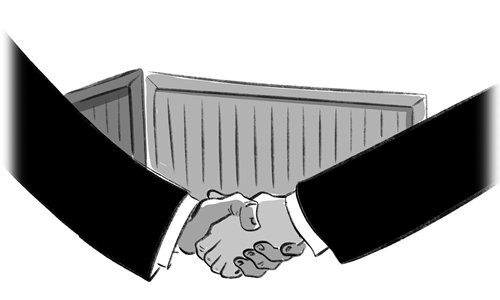HOME >> BUSINESS
EU-Vietnam free trade agreement won’t affect China’s ties to its Southeast Asian neighbor
By Xu Liping Source:Global Times Published: 2019/7/8 20:23:39

Illustration: Luo Xuan/GT
In recent years, Vietnam has signed bilateral and multilateral free trade agreements with a number of economies or economic unions. On June 30, the EU-Vietnam Free Trade Agreement (EVFTA) and the EU-Vietnam Investment Protection Agreement were officially inked in Hanoi, Vietnam's capital. Hanoi views the deal as an important milestone for its global trade.
While the EVFTA still needs approval from the European Parliament and from the governments of various EU countries, some media cannot wait to interpret it in a provocative way, insisting that Vietnam is trying to get rid of China's influence and to struggle for a bigger share in the global industrial chain. Such a view is nothing but an imagined issue.
Talks over the free trade agreement between Vietnam and the EU, which lasted for seven years, were not always smooth. In 2012, the two sides started negotiations. In 2015, they reached an agreement in principle on the bilateral free trade agreement. In 2019, they finally signed the agreement, which still requires approval from their respective legislative bodies as well as governments of EU countries to officially enter into force. According to the agreement, both sides will gradually cut and finally cancel tariffs on 99 percent of goods traded between them in the coming seven to 10 years.
Vietnam's major export products such as rice, seafood, clothing, and footwear are likely to benefit from the deal, while EU products (such as automobiles, dairy products and wine) and services may see more export opportunities to Vietnam. In terms of trade value, bilateral trade between Vietnam and the EU totaled $56.3 billion in 2018, with Vietnam being the side with a trade surplus. Once the free trade agreement takes effect, it will likely eliminate the trade imbalance between the two sides, also giving a boost to the world economy.
But the sign of a free trade agreement is also a double-edged sword for Vietnam, as the deal's impact on Vietnam's economic competitiveness and economic rules should not be overlooked. Vietnam is one of the least developed economies among the EU's free trade partners, so it will be inevitable that its economy and companies will face great pressure. The relatively high standards of production regarding environment and geographical indicators, as well as the excessively high standards of human rights and labor rights are expected to affect the Southeast Asian country in an all-round way. How Vietnamese companies and regulators will deal with these challenges to truly increase the exports of Vietnamese products to the EU is key to whether Vietnam will be able to seize the opportunity brought by the free trade agreement.
Since Vietnam's economic reforms, which started in 1986, its government has been expanding its foreign relations toward diversification and multilateralization by continuously introducing new measures for opening up to the outside world.
These measures are intended to facilitate Vietnam's economic transformation and upgrade to enhance the competitiveness of its economy, while at the same time, they also aim to deal with the dual challenges of globalization and anti-globalization to help the Vietnamese economy further integrate into the world economy.
While the Vietnamese economy is strengthening the link to the world, there has been no decoupling between China and Vietnam, instead, ties have become stronger. In recent years, the Sino-Vietnam economic and trade relations have undergone rapid development, with increasing bilateral cooperation and growing common interests. In 2018, bilateral trade between the two countries reached $147.86 billion, up 21.2 percent year-on-year. China has become Vietnam's largest export market for fruit and vegetables, while Vietnam has become China's largest trading partner in the Association of Southeast Asian Nations. In 2018, China's newly-added contracted investment in Vietnam amounted to $2.46 billion, ranking 5th among the 106 countries and regions that have investment in Vietnam. China's accumulative investment in Vietnam was $13.3 billion.
Given their different economic sizes, China and Vietnam are not seriously locked in a competitive relationship. In 2018, Vietnam's GDP was $240 billion, while China's GDP exceeded 90 trillion yuan ($13.6 trillion), equivalent to 56 times Vietnam's GDP. In the same year, China's trade with the EU was up to 600 billion euros ($674 billion), more than 10 times that between Vietnam and the EU.
China and Vietnam are good partners, good neighbors and good friends. While there are disputes between them on the South China Sea and some other issues, they are just partial problems both sides are dealing with through bilateral channels.
Under the framework of a comprehensive strategic partnership, Sino-Vietnam relations have been constantly progressing and deepening in terms of political security, economic and trade cooperation, and people-to-people exchanges. It is ridiculous to think that Vietnam is trying to get rid of Chinese influence, which is totally inconsistent with the facts.
The author is director of the Center for Southeast Asian Studies of the Chinese Academy of Social Sciences. bizopinion@globaltimes.com.cn
Posted in: EXPERT ASSESSMENT